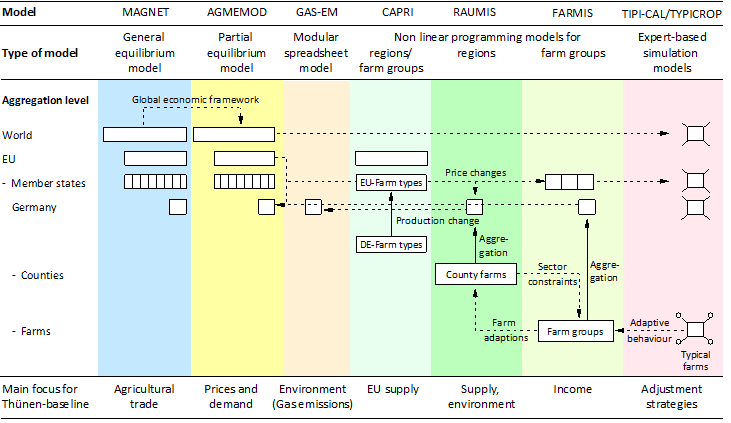How do policy changes affect agriculture, agricultural markets and the environment? The Model Network of the Thünen Institute uses economic models to estimate the consequences of political action and thus supports policymakers in their decisions.

What are the impacts of the next EU agricultural policy reform and the new trade agreements on the cultivation and the import of renewable raw materials? How does this affect the regional concentration of energy crops in Germany? Are the net environmental effects positive? And what does this mean for the income of a typical farm in the Hildesheimer Börde?
The policy areas relevant to agriculture are subject to constant change. This has led to an increased demand from policy makers and scientists to quantify the consequences of policy changes in advance. To do so requires taking into account numerous interactions. Models help to reduce the complexity of the real world to the essential relationships, and thus contribute to a better understanding.
The Modelling Network of the Thünen Institute use economic models for different decision levels (e.g., farm, regional or sector). The joint application of the models facilitates the consistent consolidation of the different levels. The results of our model-based policy impact assessments support policy makers in identifying potential need for action, in developing negotiation positions, and in designing policy instruments.
Structure of the Modelling Network
The Thünen Modelling Network uses mathematical-economic simulation models, each describing various decision-making levels: MAGNET simulates developments and policies in the area of world economics in general as well as those of individual countries and regions. The AGMEMOD model deals with the important agricultural markets of the EU Member States as well as interactions between the agricultural and food sectors. The CAPRI model is used to evaluate EU agricultural policy at the European level. RAUMIS presents adjustments of agricultural land use and production in Germany at the regional level. FARMIS uses a bottom-up approach to farms and farm groups for its farm modelling and includes a projection of the results at sectoral level. The single farm models TIPI-CAL and TYPICROP complement this approach for special analyses and adaptation strategies and offer the possibility of a direct feedback with farmers.
The various models are used for different questions depending on their individual emphases. A particular strength of applying the models jointly in a network is the consistent consolidation of different areas and aspects covered by the individual models, allowing us to capture the complex interactions between the decision-making levels. Thünen Institute scientists who participate in the modelling network working group, play a particularly important role in this context. They apply their expertise to the maintenance, updating and further development of the models in an active exchange of scientific knowledge.
How does the Thünen Modelling Network work?
The analysis of a particular question starts with a first consultation of out modelling team with representatives of the Federal Ministry. Here, relevant scenarios (e.g., the abolishment of the milk quota) and central assumptions (e.g., the future development of energy prices) are discussed. Depending on the complexity if the problem and the relevant interactions, we decide which models are required for the analysis and if and how these need to be developed further. In the subsequent analysis, a coordinated, parallel and/or iterative use of the model follows. This facilitates the consolidation of important assumptions, an exchange of results between model, and the mutual monitoring and control of model results. This approach ensures a coherent overall picture and also helps to identify and reduce uncertainties in the projection results.
A central element of the work of the modelling network is the regular establishment of a so-called "baseline", that is a projection of expected developments in the agricultural sector under the framework of current (agricultural) policy. The Thünen Baseline is developed in close cooperation with experts German Ministry of Food and Agriculture; it serves as a reference scenario for policy impact assessments.
How will the Thünen Modelling Network be developed further?
Continuing to develop the modelling network in terms of content, technology and strategy is of central importance in order to continually and promptly carry out quantitative assessments of the policy impacts. To this end, the development of the agri-economic models is closely linked to other research carried out at the institute as well as to national (e.g. Agrum Germany) and international (e.g. CAPRI, AGMEMOD, GTAP, agri benchmark) networks.
Researchers financed by third party funding help to study relevant future topics and developments and enable the modelling network to commence time-intensive model developments at an early stage.


![[Translate to English:] The team members of the Modelling Network](/media/_processed_/9/b/csm_F_Gruppenfoto_01-03-2023_DSC5793-06-03-23_aee77f3033.jpg)
![[Translate to English:] Germany's agriculture until 2034](/media/_processed_/7/3/csm_DSC_1818_large_87a383d109.jpg)





